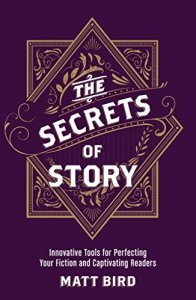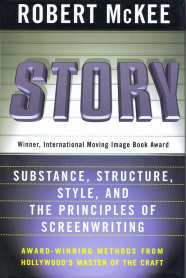7 Tips for How to Add Complexity to Your Story
 So you want to add complexity to your story. Most authors do. Complexity just sounds so… sophisticated. It sounds like one of those novels or films that are taken apart and analyzed by really smart critics and professors. It sounds like taking your story to the next level.
So you want to add complexity to your story. Most authors do. Complexity just sounds so… sophisticated. It sounds like one of those novels or films that are taken apart and analyzed by really smart critics and professors. It sounds like taking your story to the next level.
And in some ways, it is. Complex stories are things of beauty. These are the stories that entertain audiences beyond just the moment. These are the stories we come back to over and over again, gaining some new insight or appreciation with every re-reading or re-watching.
There is, however, a difference between a story that is successfully complex and one that is just complicated. I talked about this in last week’s post “Is Your Story Too Complicated? Here Are 9 Signs,” which I shared in answer to reader Lila Diller’s request:
Could you define more clearly what you mean about the difference between complex & complicated?
In that post, I pointed out nine different ways stories may be unintentionally and deleteriously complicating themselves. Most of these examples had to do with too many random pieces that just aren’t coming together into a cohesive whole.
In this week’s post, I want to look at the other side of the coin. What is complexity in a story? And what are some tools you can use for how to add complexity to a story without crossing the line into complications?
What Is a Complex Story?Both complexity and complication arise out of “many parts.” The difference is that, perhaps surprisingly, complexity actually keeps things quite simple. “Complicated” stories offer many different elements, most of which stay on the surface. “Complex,” by contrast, puts most of its focus on a few elements, but goes deep.
“Complicated” is clutter; “complexity” is layers.
As you can see, the irony here is that to achieve complexity via depth, you must keep things comparatively simple. Simplicity and complexity walk hand in hand.

Secrets of Story by Matt Bird (affiliate link)
I love how Matt Bird explains this. In his book Secrets of Story, he talks about a realization he had while troubleshooting the plot in one of his scripts:
I suddenly realized my characters spent all their time talking about the plot, explaining it to themselves and explaining it to the audience. This is inevitable when the plot is too complicated. But a good plot should be simple enough that both the characters and the audience understand it just by looking at it.
Sometimes writers write themselves into this conundrum somewhat on purpose, believing readers will be impressed by what is, in reality, just a confusing plot. Often, however, we write ourselves into complications because, when story problems start cropping up, we write one ad hoc solution to this problem and another ad hoc solution to that problem—until, suddenly, as per Blake Snyder, we’ve got “dumble mumbo jumbo” all over the place (and you can add in “toil and trouble,” for my money). The result, as Bird points out, is that we double our word count trying to explain how all these disparate elements somehow really do belong together.
7 Tips for How to Add Complexity to Your StoryOn occasion, excellent writers will be able to explain their way out of their own messes. Usually, not so much. The much better solution is to recognize which tools will help you create a story of cohesive complexity right from the start. Here are seven tips for how to add complexity to your story, without the complications.
1. Adhere to a Clear Structural and Thematic Throughline or Unifying Idea
Writing Your Story’s Theme (Amazon affiliate link)
Start with the bones. Even the most complex stories (scratch that—especially the most complex stories) should be based upon solid structural and thematic throughlines that are so simple and obvious they can be summed up in a short sentence. If you find yourself wanting to add a lot of “and’s” to this sentence, you know you’re probably straying off the straight and narrow.
This doesn’t mean your official premise sentence necessarily has to be that simple, but the explanation of the plot should be. For instance, consider Game of Thrones. The premise is extremely complicated. But the plot? An all-out battle for the throne before the apocalypse hits. That throughline guides every disparate element and scene in the story.
The first step here is, obviously, to identify your structural throughline (what are characters trying to accomplish and/or stop each other from accomplishing?) and your thematic premise (what thematic element informs the overall story and every character’s role within it?). From there, make sure all of your story’s major structural beats and all of your major character arcs are synced to these guiding lights.

The Great Escape offers one of my favorite examples of how to use cohesive structural beats (in this case adding in a structural focus on the subplot of Steve McQueen’s character) to anchor even a story with a huge cast of characters. Read a structural breakdown of The Great Escape here.
2. Utilize Dramatic Irony Via Both Contrast and ComparisonIrony almost always brings complexity on board. Wherever there is subtext—wherever what isn’t obvious on the surface is just as important as what is obvious—there will be depth. Where there is depth, there is complexity. Irony at its simplest is a sarcastic character saying the opposite of what he means. At perhaps its most complicated, dramatic irony is a satire that you aren’t quite sure is satire—an entire story built as a subtle critique of the very thing it proposes to be (such as, famously, Jane Austen’s Northanger Abbey).
On a more practical level, irony arises when contrast emerges from a homogeneous sea of comparisons. One of my favorite ways to create this is through the comparison of the protagonist to an antagonist who is really not so different and the contrast of a protagonist to an ally who is really quite different.
Most specifically, look for ways you can surprise readers by subverting their expectations. Maybe they expect your child character to be adorable, but really she’s heinous. Maybe they expect the antagonist to be heinous but really he’s the adorable one. Maybe they expect the hero to do the right thing, but she doesn’t. Surprises, by themselves, will not necessarily create depth or complexity, but when this added dimension allows your audience to see deeper into characters and situations, you will likely have just added complexity.

One of the reasons Gollum, from The Lord of the Rings, has become such an enduringly iconic character is because he surprises us. For all his grotesqueries and even downright evil, he is also the earnest and heart-wrenching Smeagol whom Gandalf encourages Frodo to pity.
3. Create Thematic Squares
Story by Robert McKee (affiliate link)
A straightforward thematic expression based on a solid character arc is enough to create a good story. But if you really want to up your game into complexity, while still keeping everything streamlined, consider the thematic square. This wonderful tool, originating in Robert McKee’s book Story, is something I’ve discussed in depth in this post.
Basically, it allows you to fill out all four “corners” of your story’s theme, exploring not just a proposed positive Truth, but all its many angles and oppositions. Because you’re focusing on one theme, you will maintain simplicity, but by drilling deep on that one theme, you can suss out all its potential complexities (and give those really smart critics and professors something to talk about).

The western True Grit explores themes of justice and injustice, with every character representing some varying face of one of these polarities.
4. Make Use of the Four Corners of Opposition
The Anatomy of Story by John Truby (affiliate link)
Similarly (and something I also talk about in the above linked post, as well as this one), you can use John Truby’s tool, from his book The Anatomy of Story, to develop a robust and fleshed-out plot. Conflict between your protagonist and antagonist is simple; conflict between your protagonist and the antagonist, the protagonist and the sidekick, the antagonist and the sidekick, the sidekick and the love interest, the protagonist and the love interest, the antagonist and the love interest (you get the idea), that’s complex.
You don’t have to limit yourself to just four characters. Basically, this tool is simply a reminder that conflict (aka, obstacles) should not exist merely in a straight line between your protagonist and your antagonistic force, but potentially between every character in a wide array of possible relationships. This doesn’t mean everybody has to be at everybody’s else throat full bore all the time. The complexity only gets juicier when there are nuanced degrees of opposition in each varied relationship.

Guardians of the Galaxy is one of many films in the Marvel Cinematic Universe that successfully adds complexity to its characters’ relationships by bringing out not just conflict between the protagonist and the antagonist, but also within the group dynamics of an allied team.
5. Focus on Rich Archetypal or Metaphoric IntentSpot-on symbolism is one of the most powerful ways to add complexity to a story. Why? Because symbolism is inherently both simple and complex.
Symbolism is simple because it elicits a universal response from audiences. Even if different people have different opinions about a symbol, they all respond to it on some level. It is complex because it offers depth. Depending on the symbolism, it has the ability to tell a whole story all its own just through its own connotations.
Allegories are the most obvious example of this. Genre stories (such as romance and mystery) are also symbolic unto themselves. Archetypal stories, such as the Hero’s Journey (and so much more), bring a deep mythic underpinning to any type of story that understands and respects their symbolism. Even simply creating and maintaining a consistent metaphor for your story can bring a whole new layer of resonance and complexity.

Everything about Dirty Dancing is set up around the unifying metaphor of dancing as a representation of the protagonist’s burgeoning into adulthood.
6. Remember: Simple Backstory>Complex Main Story or Complex Backstory>Simple Main StoryOne area in which writers sometimes go wrong in accidentally transforming their story’s potential for complexity into unfortunate complications is in weighing down an already complicated plot with an equally complicated backstory. A good rule of thumb is that if your main story is super complex, keep the backstory simple or if your backstory is super complex, keep the main story simple.
A complicated backstory will usually function as a sort of mystery within the main plot, with the characters either actively or incidentally learning new clues as they go along. In turn, these clues influence the characters’ ability to solve the main plot, either directly or through the transformation the revelations create in their personal growth. This is great—but if the backstory revelations are crucial to the main story, this means the characters will spend a significant amount of time tracking down those clues. If they also have to spend time solving complications in the main plot (which are not directly tied in with the backstory revelations), this can lend itself, at best, to a very scattered story.
By the same token, if the main story is twisty-turny and full of mysteries and revelations (whether personal or global), a complex backstory often feels overdone and in the way.

The backstory in the Harry Potter series is deeply complex. Much of the story in the main plot hinges on the discoveries Harry makes about the events surrounding his parents’ deaths. The main plot of the series itself, however, is relatively simple, pivoting around the discovery and confrontation with an obvious villain.
7. Remember: Simple Motivation>Complex Goal or Complex Motivation>Simple GoalA similar rule of thumb is that if your characters’ goals are complex, their motivations should be simple or if their motivations are complex, the goals should be simple.
Motives are not always simplistic. A character’s reasons for wanting to marry someone, kill someone, oust someone, or meet someone can be extremely complex, veiled even to the character. The exploration of the why behind the character’s actions may consume a fair amount of space and explanation within the story. If you then burden the story with a similarly complicated goal, this can easily make the whole thing seem far too convoluted.
Vice versa, if the character’s goal is quite complex (e.g., she wants multiple things and/or her plan for getting them is deviously tricky), then you will need to allot more time to explanations of that. In this case, a complicated motive can just muddy things up.

The plot in Ocean’s 11 is purposefully complex, revolving around a difficult heist with many moving parts. Therefore, the film rightfully keeps the protagonist’s motives super simple and relatable: he wants revenge and redemption.
***
A complex story is a story that knows exactly what it is on every single page. This is true even of extremely tricky stories full of surprises. A complex story is one that is grounded in its own identity. It doesn’t need to explain what it is to readers or distract them with lengthy explanations intended to cover up its own insecurities and identity crises. Rather, it can spend its time looking deeper into its abstractions and gray areas.
Complex stories rest upon a firm foundation of structure and theme; the bones are all there. This is what allows them to stand up straight and shine out from beneath any and all exotic garb in which its writer may want to clothe it.
In short, a complex story is a good story.
Wordplayers, tell me your opinions! How to add complexity to your story—what are your favorite ways? Tell me in the comments!Click the “Play” button to Listen to Audio Version (or subscribe to the Helping Writers Become Authors podcast in Apple Podcast or Amazon Music).
___
Love Helping Writers Become Authors? You can now become a patron. (Huge thanks to those of you who are already part of my Patreon family!)The post 7 Tips for How to Add Complexity to Your Story appeared first on Helping Writers Become Authors.




